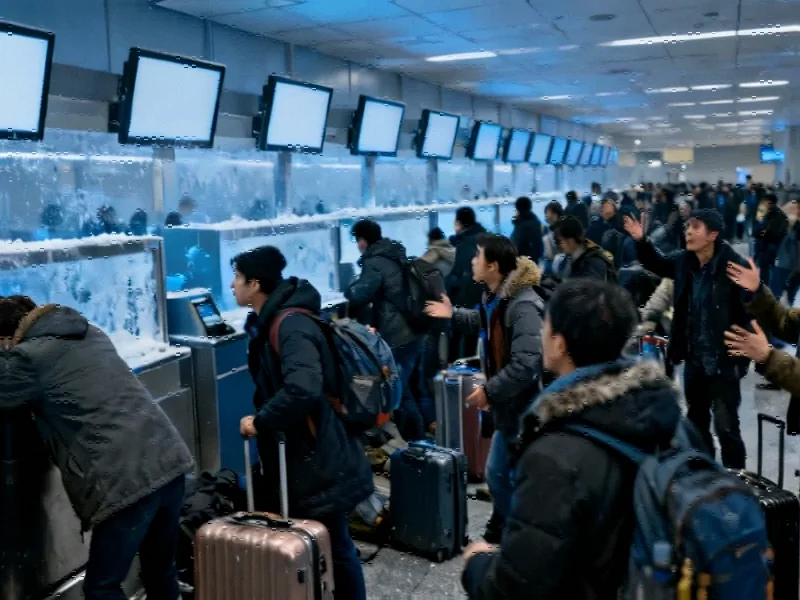Widespread Disruption Across Digital Services
Early Monday morning, a significant AWS outage demonstrated just how dependent the modern digital world has become on cloud infrastructure. The disruption affected more than 100 Amazon Web Services, creating a ripple effect that impacted everything from messaging apps to airport operations. As one of the largest cloud service providers globally, AWS supports millions of websites and applications, making any disruption to its services immediately noticeable across the digital landscape.
The outage tracker DownDetector recorded widespread issues with popular services including WhatsApp, Venmo, Hulu, and Coinbase. Even government services weren’t immune, with the United Kingdom’s official website experiencing downtime. Corporate communications from companies like Zoom and Fortnite confirmed service disruptions, while Signal’s chief Meredith Whittaker publicly acknowledged the AWS-related issues on Bluesky.
Airport Chaos and Travel Disruptions
The real-world consequences became particularly evident at airports across the United States. United and Delta airlines reported app failures that prevented passengers from checking in for flights, creating long lines and operational headaches. United’s social media team responded to numerous customer complaints, acknowledging that their systems were affected by the AWS crash.
This technological failure comes at an especially challenging time for air travel, with airports already grappling with government shutdown impacts and ongoing staffing shortages in critical positions like air traffic control. The timing highlights how multiple systemic vulnerabilities can converge to create perfect storms in transportation infrastructure.
Technical Root Cause Analysis
Amazon’s initial investigation pointed to DNS resolution problems with its DynamoDB service as the core issue. This database offering from AWS experienced difficulties translating user-friendly domain names into machine-readable IP addresses, effectively creating a digital traffic jam that prevented services from communicating properly.
The problem originated from a DynamoDB API endpoint in the US-EAST-1 region, which has its physical infrastructure centered in northern Virginia. This regional concentration meant that any issues quickly spread to other services relying on the same infrastructure, demonstrating the interconnected nature of modern cloud architecture. Similar to how space infrastructure developments require robust backup systems, cloud services need greater redundancy to prevent single points of failure.
Comparative Impact Assessment
While disruptive, Monday’s outage was notably more contained than last year’s Crowdstrike incident that caused global chaos for several days. The Crowdstrike outage resulted in thousands of flight cancellations and delays, costing Delta Airlines approximately $500 million in losses. This latest event, while significant, appears to have caused only minor delays according to initial reports from affected airlines.
The incident raises important questions about how AI and automation tools might help predict and prevent such widespread service disruptions in the future. As detailed in our coverage of major AWS disruption, the dependency on centralized cloud infrastructure creates systemic risks that require innovative solutions.
Broader Implications for Digital Infrastructure
This incident underscores the critical vulnerability created by over-reliance on a handful of cloud providers. When a few companies supply the foundational infrastructure for much of the internet, even minor technical issues can cascade into global disruptions affecting millions of users.
The current configuration of internet services creates a paradox: while cloud computing offers unprecedented scalability and efficiency, it also concentrates risk. As we’ve seen with practical AI implementations in industrial settings, distributed systems with built-in redundancy often provide more resilience than centralized alternatives.
- Service Concentration Risk: Heavy reliance on AWS, Azure, and Google Cloud creates systemic vulnerabilities
- Cascade Effects: Single points of failure can impact unrelated services globally
- Business Continuity Planning: Companies need multi-cloud strategies and offline backup systems
- Infrastructure Diversity: Future systems may require more distributed architectures
As digital transformation continues to accelerate across all sectors, Monday’s outage serves as a crucial reminder that reliability must remain a paramount concern in our increasingly connected world. The incident highlights why understanding industry developments in cloud infrastructure and exploring related innovations in distributed systems should be priorities for any organization dependent on digital services.
This article aggregates information from publicly available sources. All trademarks and copyrights belong to their respective owners.
Note: Featured image is for illustrative purposes only and does not represent any specific product, service, or entity mentioned in this article.



